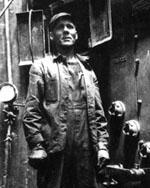
Harry G. Dyer
The Log of Harry G. Dyer: Steamboatman,
Upper Mississippi, 1881-1902
Bell and Whistle Signals of Mississippi River Rafting Steamboats
HARRY G. DYER
Bells
For sternwheel steamboats, the stopping and starting bell was on the
starboard side of the engine room, the right side facing the bow. The
backing bell was on the left, or port, side.
We will suppose that the boat is under way and it becomes necessary to stop
and back. The pilot rings the stopping bell, the engineer then closes the
throttle valve and stops the engines. The backng bell is rung and the
reverses the engines. This is done by merely pulling a lever. At the next
ring of the backing bell he opens the throttle valve wide open. The boat is
then backing strong. If the backing bell rings again, he closes the
throttle valve part way and she is backing slow. If the bell rings again or
the fourth time, she is again backing strong.
At the ring of the stopping bell, the engines are stopped. Then, if the
stopping bell rings again, the engines are reversed and she comes ahead
full speed. Then, if the backing bell rings while she is coming ahead, she
is slowed down to half speed. Another ring of the backing bell and she is
again put at full head. The starting and stopping of the engines is
governed by the stopping bell, the shipping up and rate of speed by the
backing bell.
On sidewheel boats, the bells and signals are the same, but there are
two bells for each engine, as the engines are separate. On a sidewheeler,
one engine may be coming ahead and the other backing at the same time if
necessary, as in turning the boat around or getting out from a landing. The
sidewheel boat was easier to handle as the rudder was behind the wheels.
The sidewheel boat had one rudder, the sternwheel boat always two and
sometimes three or four according to the size of the boat.
Whistles
The whistle was used in landing, and when two boats were meeting. In
meeting the descending, i.e., the boat going downstream has the choice of
the river, but the ascending boat whistles first. Why, I do not know. In
meeting, one blast of the steam whistle means keep to the right and two
blasts means keep to the left. So two boats are meeting, the ascending boat
blows one whistle and, if agreeable to the pilot of the descending boat, he
answered with one whistle; but in case he does not agree, he must blow five
short whistles, then after a short interval, blow two whistles which the
pilot of the ascending boat must answer with two whistles, then both boats
bear a little to the right.
The blowing of five short whistles is also a "call to quarters" in case
of fire or a serious accident when each man on the boat has his place and
duty. The landing whistle of a company owning two or more boats is the
same. For instance, the landing whistles of the Diamond Jo line boats were
two long and two short whistles; the Bronson and Folsom Company, three long
and one short; the C. Lamb and Son Company, two long, a short, and a long,
etc. Five long whistles meant the boat was in trouble or in distress.
Other Bells and Whistles
The big bell on the hurricane roof of the boat was used to let the
leadsmen know when to sound water. One tap of the bell meant sound on the
right, two taps, sound on the left, one tap, stop sounding. When the boat
was at a landing, three taps of the bell meant the boat was nearly ready to
leave.
A small whistle was located on top of the boilers. It was called the
ready whistle. At the three taps of the bell at a landing, if the engineer
was ready to leave, he would answer the three blasts of the ready whistle.
Also, in a close place or an emergency, one blast of the ready whistle
meant, "give her the gun" or all the engine power. Steamboat inspection law
says that all engine bells must have wire bell pulls and the two engine
bells may be rung on either side of the pilot house. For instance, the pull
from the stopping bell comes into the pilot house on the starboard side,
goes through a small pulley in the roof of the pilot house, goes across the
pilot house through another pulley and ends in a ring six or eight inches
in diameter. The backing bell pull is arranged just the opposite.
If the pilot is on the right side of the pilot house he rings the
stopping bell by taking hold of the bell pull. If he is on the left side,
he takes hold of the ring in the end of the pull. The whistle was always
blown using the pilot's foot, as sometimes he could not let go of the pilot
wheel with either hand. A treadle on the floor of the pilot house took care
of this.
There were some beautifully-toned roof bells on the Mississippi boats,
the one of the steamer OCEAN WAVE, which burned at Frontenac in Lake Pepin
on June 11, 1868, was known from St. Paul to St. Louis. When she burned,
the bell went down into the water. Sometime afterward, Captain George Knapp
fished it out and found it to be cracked; he had it brazed but the tone was
never the same. It is now on a church in some small town in Minnesota.
Excerpts from
Upper Mississippi River Rafting Steamboats
Edward G. Mueller, Ohio University Press,
1995.
October 1941